 Getting your writing published in a literary journal is an important way to improve your chances of getting your nonfiction (or memoir) book manuscript published. When your writing is published in a literary journal it provides a publisher with evidence you can meet professional standards and others find your work compelling. Literary journals are often considered gatekeepers to the publishing community.
Getting your writing published in a literary journal is an important way to improve your chances of getting your nonfiction (or memoir) book manuscript published. When your writing is published in a literary journal it provides a publisher with evidence you can meet professional standards and others find your work compelling. Literary journals are often considered gatekeepers to the publishing community.
Which literary journals should you consider? Poets & Writers has a wonderful tool to help you narrow your search of more than 800 literary magazines listed there depending on your genre and subgenre. Not all literary journals, however, are the same. It is important to read several issues of a magazine before you submit. When you have read enough to recognize what you might contribute, then read through the submission guidelines carefully. Note deadlines and reading periods. Keep in mind a journal can only publish a handful of pieces out of the thousands of submissions, they are often run by volunteers at a financial loss, and most spend their time trying to carry out vital functions to publishing a magazine instead of providing critical feedback on how to improve your writing craft.
There are 9 publications I recommend to writers of nonfiction and memoir, although not all of them are suitable for every book project or author. Their editorial quality is excellent and reading them will increase your understanding of the professional expectations for publication. This list is collated from information provided on the websites hot-linked here.
And remember, read before you write.
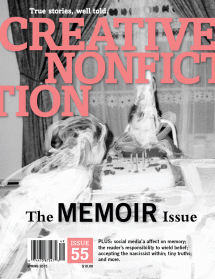 Creative Nonfiction is the “voice of the genre. Every issue is packed with new, long-form essays that blend style with substance; writing that pushes the traditional boundaries of the genre; notes on craft; micro-essays; conversations with writers and editors; insights and commentary from CNF editor Lee Gutkind; and more. Simply put, CNF demonstrates the depth and versatility of the genre it has helped define for more than 20 years.”
Creative Nonfiction is the “voice of the genre. Every issue is packed with new, long-form essays that blend style with substance; writing that pushes the traditional boundaries of the genre; notes on craft; micro-essays; conversations with writers and editors; insights and commentary from CNF editor Lee Gutkind; and more. Simply put, CNF demonstrates the depth and versatility of the genre it has helped define for more than 20 years.”
 Hippocampus Magazine “Donna Talarico first dreamed of Hippocampus Magazine while she was working on her MFA in creative writing at Wilkes University… Her vision was to create not just a literary magazine filled with fresh memoir excerpts and memorable essays, but also to develop a venue to educate and inform those interested in reading and writing creative nonfiction. Adding craft articles, book reviews and interviews would add value to Hippocampus Magazine. A mix of timely and timelessness.”
Hippocampus Magazine “Donna Talarico first dreamed of Hippocampus Magazine while she was working on her MFA in creative writing at Wilkes University… Her vision was to create not just a literary magazine filled with fresh memoir excerpts and memorable essays, but also to develop a venue to educate and inform those interested in reading and writing creative nonfiction. Adding craft articles, book reviews and interviews would add value to Hippocampus Magazine. A mix of timely and timelessness.”
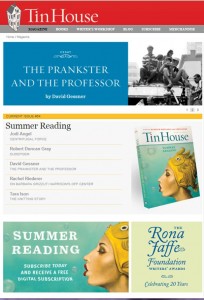 Tin House “The first issue of Tin House magazine arrived in the spring of 1999, the singular lovechild of an eclectic literary journal and a beautiful glossy magazine…Tin House offers an artful and irreverent array of fiction, nonfiction, poetry, and interviews as well as columns on food and drink, out-of-print and underappreciated books, and a literary crossword puzzle. Perhaps most indicative of the magazine’s mission to stake out new territory and showcase not only established, prize-winning authors is its commitment that every issue include the work of an undiscovered fiction writer and poet”.
Tin House “The first issue of Tin House magazine arrived in the spring of 1999, the singular lovechild of an eclectic literary journal and a beautiful glossy magazine…Tin House offers an artful and irreverent array of fiction, nonfiction, poetry, and interviews as well as columns on food and drink, out-of-print and underappreciated books, and a literary crossword puzzle. Perhaps most indicative of the magazine’s mission to stake out new territory and showcase not only established, prize-winning authors is its commitment that every issue include the work of an undiscovered fiction writer and poet”.
 Kenyon Review “was founded in 1939. The resources for the new literary journal were provided by Gordon Keith Chalmers, President of Kenyon College, while the inspiration had been conceived some years before by his wife, Roberta Teale Swartz…It was perhaps the best known and most influential literary magazine in the English-speaking world during the 1940s and ’50s. In 1969, discouraged by the quarterly’s financial burdens and sagging reputation, Kenyon College ceased publication of The Kenyon Review. The journal was revived in 1979, and in June 1990, internationally acclaimed poet and editor Marilyn Hacker was hired as the Review‘s first full-time (and first female) editor. She quickly broadened the quarterly’s scope to include more minority and marginalized viewpoints. In April 1994, the trustees directed that The Kenyon Review be continued, but with significant cost-reducing and revenue-enhancing initiatives. Hacker left and David Lynn (acting editor in 1989-90), Kenyon English professor, was named editor on a two-thirds time basis. The magazine’s financial picture has since stabilized and improved dramatically. The creation of a Kenyon Review Board of Trustees and a renewed commitment by Kenyon College combined to guarantee the financial health of the Review and to free its editors to pursue increased excellence. Such is the status of The Kenyon Review today.”
Kenyon Review “was founded in 1939. The resources for the new literary journal were provided by Gordon Keith Chalmers, President of Kenyon College, while the inspiration had been conceived some years before by his wife, Roberta Teale Swartz…It was perhaps the best known and most influential literary magazine in the English-speaking world during the 1940s and ’50s. In 1969, discouraged by the quarterly’s financial burdens and sagging reputation, Kenyon College ceased publication of The Kenyon Review. The journal was revived in 1979, and in June 1990, internationally acclaimed poet and editor Marilyn Hacker was hired as the Review‘s first full-time (and first female) editor. She quickly broadened the quarterly’s scope to include more minority and marginalized viewpoints. In April 1994, the trustees directed that The Kenyon Review be continued, but with significant cost-reducing and revenue-enhancing initiatives. Hacker left and David Lynn (acting editor in 1989-90), Kenyon English professor, was named editor on a two-thirds time basis. The magazine’s financial picture has since stabilized and improved dramatically. The creation of a Kenyon Review Board of Trustees and a renewed commitment by Kenyon College combined to guarantee the financial health of the Review and to free its editors to pursue increased excellence. Such is the status of The Kenyon Review today.”
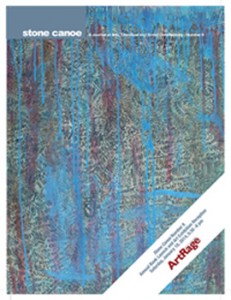 Stone Canoe, a journal of arts and ideas from Syracuse, New York, is “published annually, each spring, by the YMCA’s Downtown Writers Center, a program of the Arts Branch of the YMCA. The journal was founded at Syracuse University by founding editor Robert Colley. Stone Canoe showcases the work of a diverse mix of emerging and well-established artists and writers with connections to Upstate New York. In doing so, we hope to promote a greater awareness of the cultural and intellectual richness that characterizes life in the region.”
Stone Canoe, a journal of arts and ideas from Syracuse, New York, is “published annually, each spring, by the YMCA’s Downtown Writers Center, a program of the Arts Branch of the YMCA. The journal was founded at Syracuse University by founding editor Robert Colley. Stone Canoe showcases the work of a diverse mix of emerging and well-established artists and writers with connections to Upstate New York. In doing so, we hope to promote a greater awareness of the cultural and intellectual richness that characterizes life in the region.”
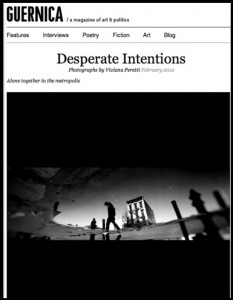 Guernica Magazine. ”An online magazine of ideas, art, poetry, and fiction published twice monthly. Guernica contributors come from dozens of countries and write in nearly as many languages. They include acclaimed writers like Chimamanda Ngozi Adichie, Bei Dao, J. Malcolm Garcia, Mark Dowie, Lis Harris, Jonathan Steele, George Szirtes, Adonis, Victoria Redel, Norman Solomon, Richard Howard, Julian Rios, Edith Grossman, Sasha Polakow-Suransky, Tom Engelhardt, Tariq Ali, Susie Linfield, Pierra Bayard, Horacio Castellanos Moya, Alimorad Fadie Nia, Marie Monique Robin and Shelley Jackson, as well as brilliant younger writers like Rivka Galchen, Deb Olin Unferth, Porochista Khakpour, Mark Binelli, Josh Weil, Jesse Ball, Sadanand Dhume, Monica Ferrell and Laura van den Berg. Guernica guest fiction editors include Claire Messud, Brenda Wineapple, Sam Lipsyte, George Saunders, Francisco Goldman, and Ben Marcus.”
Guernica Magazine. ”An online magazine of ideas, art, poetry, and fiction published twice monthly. Guernica contributors come from dozens of countries and write in nearly as many languages. They include acclaimed writers like Chimamanda Ngozi Adichie, Bei Dao, J. Malcolm Garcia, Mark Dowie, Lis Harris, Jonathan Steele, George Szirtes, Adonis, Victoria Redel, Norman Solomon, Richard Howard, Julian Rios, Edith Grossman, Sasha Polakow-Suransky, Tom Engelhardt, Tariq Ali, Susie Linfield, Pierra Bayard, Horacio Castellanos Moya, Alimorad Fadie Nia, Marie Monique Robin and Shelley Jackson, as well as brilliant younger writers like Rivka Galchen, Deb Olin Unferth, Porochista Khakpour, Mark Binelli, Josh Weil, Jesse Ball, Sadanand Dhume, Monica Ferrell and Laura van den Berg. Guernica guest fiction editors include Claire Messud, Brenda Wineapple, Sam Lipsyte, George Saunders, Francisco Goldman, and Ben Marcus.”
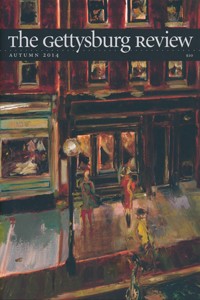 Gettysburg Review. “Since its debut in 1988, this literary journal has published the writings of E.L. Doctorow, Rita Dove, James Tate, Joyce Carole Oates, Richard Wilbur, and Donald Hall, among others. They publish 2 percent of manuscripts submitted annually and editors have eclectic tastes. They look for writers who can shape language in thoughtful, surprising and beautiful ways AND who have something unique to say, whatever the subject matter or aesthetic approach.”
Gettysburg Review. “Since its debut in 1988, this literary journal has published the writings of E.L. Doctorow, Rita Dove, James Tate, Joyce Carole Oates, Richard Wilbur, and Donald Hall, among others. They publish 2 percent of manuscripts submitted annually and editors have eclectic tastes. They look for writers who can shape language in thoughtful, surprising and beautiful ways AND who have something unique to say, whatever the subject matter or aesthetic approach.”
 Ploughshares at Emerson College publishes issues four times a year. “Two of these issues are guest-edited by different, prominent authors. A third issue, a mix of both prose and poetry, is edited by our staff editors. The fourth issue, our Ploughshares Solos Omnibus, is the annual print anthology of the year’s digitally published Ploughshares Solos. The Spring 2015 issue will be guest-edited by Neil Astley. The Summer 2015 issue will be guest-edited by Lauren Groff. The Winter 2015-2016 issue will be staff-edited.”
Ploughshares at Emerson College publishes issues four times a year. “Two of these issues are guest-edited by different, prominent authors. A third issue, a mix of both prose and poetry, is edited by our staff editors. The fourth issue, our Ploughshares Solos Omnibus, is the annual print anthology of the year’s digitally published Ploughshares Solos. The Spring 2015 issue will be guest-edited by Neil Astley. The Summer 2015 issue will be guest-edited by Lauren Groff. The Winter 2015-2016 issue will be staff-edited.”
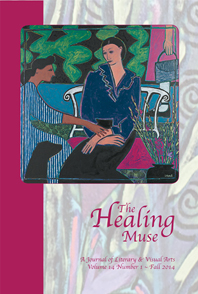 The Healing Muse is the “annual journal of literary and visual art published by SUNY Upstate Medical University’s Center for Bioethics & Humanities. We welcome fiction, poetry, narratives, essays, memoirs and visual art, particularly but not exclusively focusing on themes of medicine, illness, disability, and healing.”
The Healing Muse is the “annual journal of literary and visual art published by SUNY Upstate Medical University’s Center for Bioethics & Humanities. We welcome fiction, poetry, narratives, essays, memoirs and visual art, particularly but not exclusively focusing on themes of medicine, illness, disability, and healing.”

River Teeth is also an exquisite journal of memoir and CNF. Thank you for this piece. I didn’t know about The Healing Muse and I think I may have something that would fit there.
Thanks Jayne Martin for stopping by here. And many thanks for mentioning RIVER TEETH as another excellent literary journal. “Where good writing counts and facts matter.” That’s my kind of journal.
Thanks so much for including Hippocampus Magazine on this wonderful list.
You’re welcome!